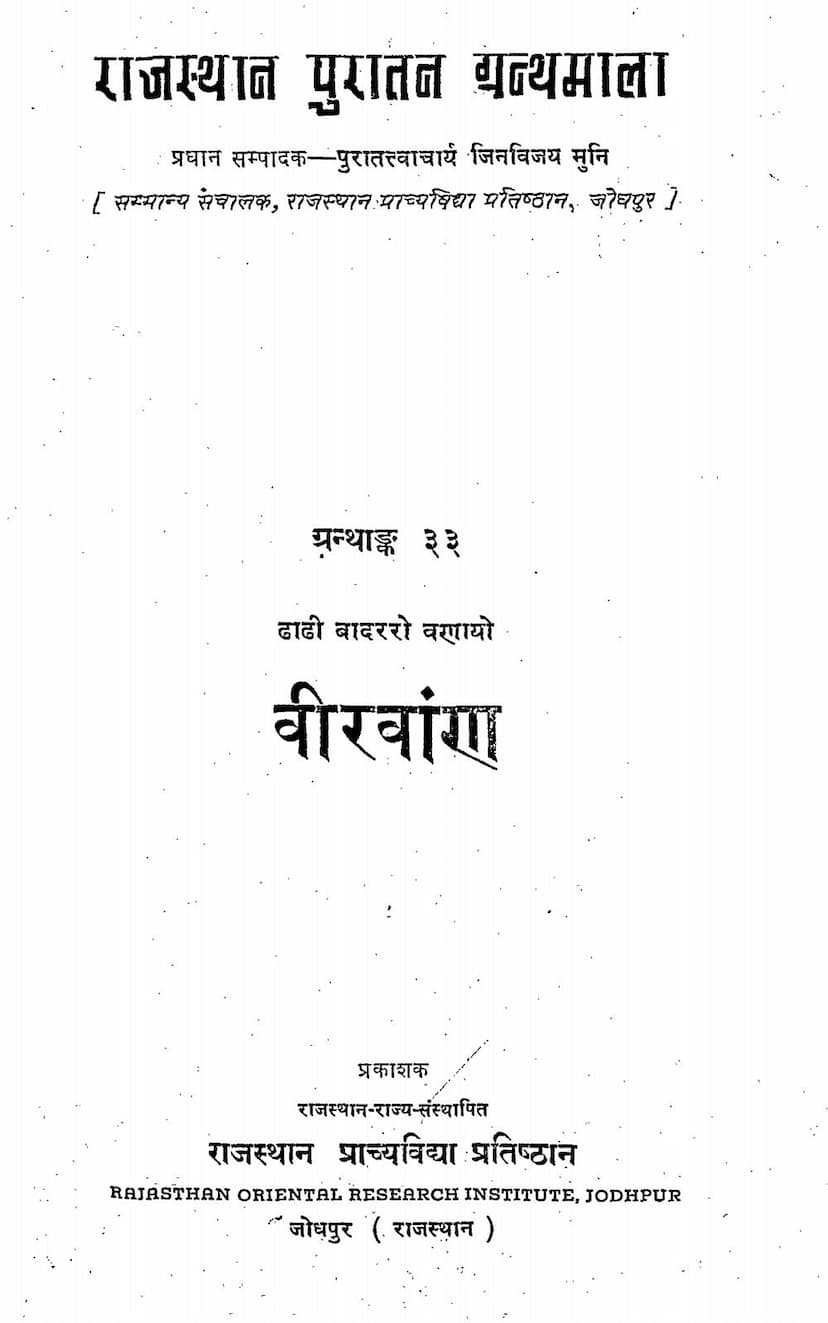Veervaan
Added to library: September 2, 2025

Summary
Here is a comprehensive summary of the Jain text "Veervaan" by Rani Lakshmikumari Chundavat:
Book Title: Veervaan Author: Rani Lakshmikumari Chundavat Publisher: Rajasthan Prachyavidya Pratishthan, Jodhpur Year of Publication: 1960 AD (V.S. 2017)
Overview:
"Veervaan" is a significant literary and historical work composed in the Rajasthani language by a Muslim poet named Badar (also known as Bahadur) of the Dhadi community. The text chronicles the valor and exploits of the Rathore warrior Viramji, a prominent figure associated with the history of Marwar. The publication of this manuscript was a collaborative effort between Rani Lakshmikumari Chundavat, a renowned scholar and writer from Rajasthan, and the Rajasthan Oriental Research Institute, Jodhpur, under the patronage of the Rajasthan Government. The book is part of the "Rajasthan Puratana Granthamala" series, aimed at preserving and promoting ancient Rajasthani literature.
Key Themes and Content:
-
Historical Narrative: The primary focus of "Veervaan" is the historical account of the life and battles of Viramji, a Rathore chieftain. The poem details his bravery, his struggles, and his interactions with various figures and communities of his time.
-
Author's Identity and Context: The author, Badar, was a Muslim Dhadi poet. The text itself acknowledges this, with Badar stating that he is from the Joiya community (a Muslim community) and that he has presented the facts as he heard them. This aspect highlights the inclusive nature of medieval Rajasthani literature, where poets from different religious backgrounds contributed to the historical and cultural narrative. The preface by Rani Lakshmikumari Chundavat emphasizes that the Dhadi community's literary contributions were often overlooked due to societal prejudices, and "Veervaan" aims to bring such neglected works to light.
-
Key Events and Characters:
- Worship and Invocation: The poem begins with invocations to Goddess Saraswati (Sharada) and Lord Ganesha, a common practice in Indian literature.
- Praise of Viramji and Rathore Lineage: Badar describes the lineage of Viramji, stemming from Rao Salha, and praises the bravery of his four sons.
- Battles and Conflicts: The text narrates several significant conflicts:
- Jait Singh's conflict with Gujarat: An account of Jait Singh's battle against the Parmars of Gujarat and his victory.
- Maldevji's conflict with Muhammad Begada: This section details Maldevji's military campaigns against the Gujarat Sultan Muhammad Begada, including the famous incident of rescuing "Gindoli" (a princess or a valuable object). The narrative includes descriptions of multiple skirmishes related to this event.
- Viramji and the Joiya Conflict: A substantial portion of the poem is dedicated to the complex relationship and eventual conflict between Viramji and the Joiya Muslims. It describes the reasons for their dispute, including incidents involving stolen horses and cattle, and the betrayal of trust. The text also mentions how Viramji's actions led to retaliatory actions from the Joiya community.
- Looting of Imperial Caravans: The poem highlights Viramji's daring raid on a caravan laden with gold coins belonging to the Delhi Sultan.
- Viramji's Sons: The narrative touches upon the roles and actions of Viramji's sons, particularly Chunda's capture of Mandore and Goga Dev's revenge against the Joiya leader Dalla.
-
Literary and Linguistic Features:
- Language: The poem is written in Rajasthani, characterized by its Ojas (vigor) and suitability for heroic narratives. The language shows some Punjabi influence in its grammatical structures and vocabulary.
- Poetic Devices: The text employs traditional Rajasthani poetic meters like "Nisaani" and "Duhas." The use of "Ven Sagai" (a form of alliteration or internal rhyme) is also noted.
- Historical Accuracy and Artistic License: While aiming for historical accuracy in recounting events, the poem also uses poetic embellishments to enhance the heroic portrayal of Viramji. The preface acknowledges the potential for variations in poetic compositions transmitted orally.
- Gadyansh (Prose): The manuscript includes interspersed prose sections, particularly for explanations and contextualization, which are considered well-formed in Rajasthani prose.
-
Social and Religious Harmony: The preface by Rani Lakshmikumari Chundavat highlights the poem's portrayal of religious tolerance and generosity, particularly in the context of the Muslim poet Badar describing the Hindu hero Viramji. It also points out the instances of understanding and coexistence between the Rathores and the Joiya Muslims, such as the 'Rakhi brother' relationship between Viramji's queen and the Joiya leader Dalla, which shows a spirit of mutual respect despite conflicts.
-
Editorial Contribution: Rani Lakshmikumari Chundavat's role as editor involved preparing the introduction, appendices, and glossary, making the historical and literary context accessible to a wider audience. The appendices include related historical accounts from other sources (like Muhnot Nainsi's Khyat) and textual variations from other manuscripts, adding academic depth to the publication.
Significance:
- Preservation of Heritage: "Veervaan" is a valuable addition to the corpus of Rajasthani literature, particularly shedding light on the historical period and the lives of prominent warriors like Viramji.
- Inclusivity in Literature: It demonstrates the inclusive tradition of Rajasthani storytelling, where poets from different religious backgrounds contributed to the shared cultural heritage.
- Historical Insight: The detailed narrative provides insights into the political landscape, social customs, and military strategies of 14th-15th century Rajasthan.
- Literary Merit: Despite its historical focus, the poem is noted for its vigorous language and vivid descriptions, especially of battles, showcasing the author's poetic skill.
In essence, "Veervaan" is a heroic epic that not only celebrates the martial prowess of Viramji but also offers a glimpse into the rich tapestry of medieval Rajasthani society, its literary traditions, and the cross-cultural interactions that shaped its history.